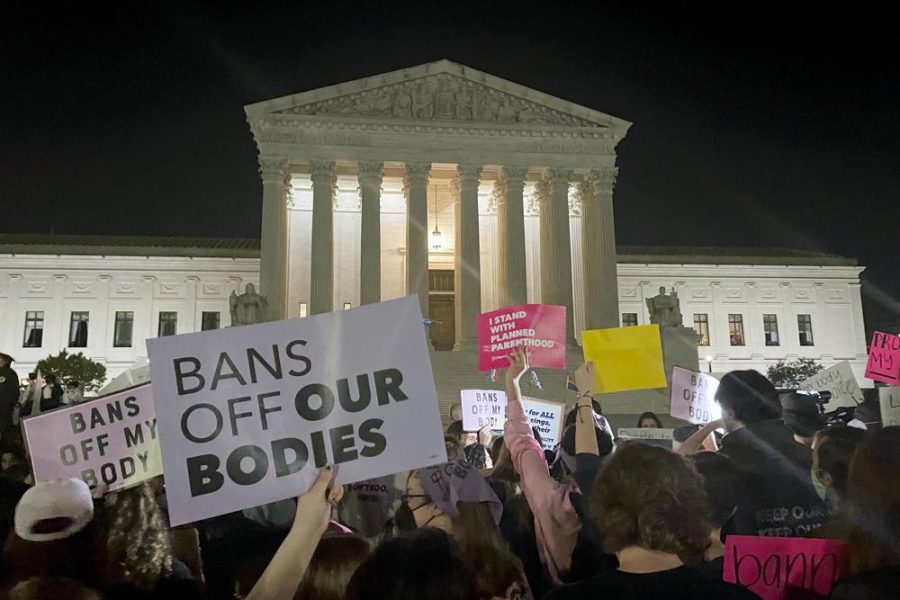Abortion has been a controversial topic throughout the lives of most college students, with politics playing a prominent role in the controversy. This was not always the case.
To understand why Republicans and Democrats are so divided on the issue, one must journey back in time to the early days of the United States. Like many issues, the context of history can help explain the present.
The early years
Before the American colonies became the United States, abortion procedures were textbook knowledge- literally.
In the 1734 textbook titled “The American Instructor”, Benjamin Franklin adapted information from a British textbook to suit the needs of people in America, according to the Ohio State professor Molly Farrell in a National Public Radio (NPR) interview. “The American Instructor” taught readers basic math and reading skills and included a section titled “Every Man His Own Doctor: The Poor Planter’s Physician,” which gave how-tos for dealing with common ailments like fevers, gout and missed periods, Farrell said.
Although a Founding Father wrote instructions for how to terminate a pregnancy, Supreme Court Justice Samuel Alito wrote in a 2022 leaked draft Opinion of the Court that “the right to abortion does not fall within [the] category” of being “deeply rooted in this Nation’s history and tradition.”
In almost 300 years since Franklin wrote about abortion, the American public’s views on the topic have become increasingly tied to politics. This was not always the case, explained University of North Florida (UNF) political science professor Dr. Sean Freeder.

“People often think of abortion as having always had this partisan conflictual element to it, that Democrats are largely Pro-choice and Republicans are largely Pro-life,” Freeder said. “If you look at public opinion in the early 1970s, if you were Pro-choice, you were slightly more likely to be Republican.”
Abortion was legal in the early days of the United States, with the concept of “quickening,” or the first detectable movements of the fetus by the mother being the cutoff for when an abortion could be performed, which was decided in an 1812 Supreme Court decision. Conflict over abortion was generally handled in lower courts and mainly concerned with instances of infanticide and late-term abortions.
In 1821 Connecticut passed the first statutory abortion regulation. However, it wasn’t to protect the fetus; rather, it was meant to protect pregnant women from unsafe abortions by barring them from using poison to terminate their pregnancies after the first four months, according to the Chicago Tribune. The law only mentioned abortions induced through substances and did not restrict other procedures for abortion.
Attitudes regarding abortions began to shift in the U.S., and in 1857 Dr. Horatio Storer helped start a movement later called “the Physicians’ Crusade Against Abortion,” which led to anti-abortion legislation being passed for the first time in many states.
With the 1873 passage of the Comstock Act, access to information about abortions and birth control was restricted. Although the Pro-life argument against abortions had started, the issue was not tied to political parties, Freeder explained.
The 20th Century
Almost 100 years later, the Comstock Act was repealed, and Roe v. Wade set a new precedent in the United States, legalizing abortion. Though still not yet strongly tied to a party, the decision for Roe v. Wade came at a time when the Supreme Court was famously liberal.
“In 1973 Roe v. Wade happens, still not super associated with one party or the other, but even a little before Roe v. Wade, you have political actors like [President] Nixon seeing that this is something that’s getting politicized and going to be a bigger issue moving forward, and he starts moving the Republican party more in the direction of Pro-life,” Freeder said.
Freeder explained that Nixon used the Pro-life movement to appeal to American Catholics but ended up appealing more to White Evangelical voters. Similarly, feminist activists on the Pro-choice side of the argument called upon Democrat leaders to boost their cause.
“By the time you get to the 1980s, Regan takes office as a Republican. He’s able now to start appointing a lot more conservative justices. As a result of this, by the time you get to the 1990s, you start to have a court that’s no longer liberal. You start to have a court that is maybe right-leaning or somewhere in the middle,” said Freeder.
It wasn’t until 1992 that abortion was mentioned as an official plank in either party’s platform. In the 1992 Republican Convention, republicans announced that the anti-abortion cause was a part of their party’s ideology, although the decision was controversial within the Republican party.

“We’ll soon see the issue of abortion become secondary in importance to the economy and world leadership,” said Republican Representative Robert Walker.
Instead of becoming a secondary issue, the debate grew in importance. As the political divide on the issue of abortion grew, the political tendencies of the justices began to play a more decisive role in their decision-making in the court.
The current state of the issue
Trump’s 2016 win in the presidential election allowed him to appoint new conservative justices to the Supreme Court, setting the stage for the court’s ability to try to overturn the decision that was made when the court leaned the opposite way.
“The change in the makeup in the supreme court in the past seven years or so has allowed for a supermajority of extraordinarily conservative justices that enabled folks that are opposed to abortion to find a pathway to getting Roe repealed,” political science professor Michael Binder said.
In February 2022, Supreme Court Justice Samuel Alito drafted an opinion to overturn the precedent set by Roe v. Wade.
Leading up to this, Texas passed a law in September 2021 banning abortions after six weeks and allowing private citizens to sue abortion providers. There was debate over if this was enforceable because of the Federal precedent set by Roe v. Wade.

Overturning Roe v. Wade would enable states to completely restrict, or in some cases expand, their laws regarding abortion, Binder explained. He discussed how previous state laws that banned or restricted abortion could be enforced.
“The opinion is not official yet, and there will be some edits and some changes,” Binder said about the leaked Supreme Court opinion.
Despite what happens to Roe v. Wade in the coming weeks, the controversy over abortion is far from over. While activists on both sides of the argument fight for what they believe in, contextualizing the fight may lead to a better understanding of different perspectives.
__
For more information or news tips, or if you see an error in this story or have any compliments or concerns, contact editor@unfspinnaker.com.

















